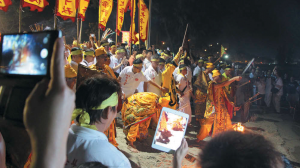The Nine Emperor Gods Festival through the Lens of Modernity
October 25, 2021

Celebrated during the ninth lunar month of the Chinese calendar, the Nine Emperor Gods Festival is commemorated by the Taoist community over a nine-day period of festivities and rituals. There are various stories behind the arrival of the Nine Emperor Gods festival in Singapore. However, it is largely believed that a man named Ong Choo Kee, who possessed a religious artefact representing the Nine Emperor Gods, built a temple in Singapore to commemorate the success endowed upon him by the gods. While the rituals differ across countries and temples, in Singapore devotees gather at designated temples to ceremoniously transport palanquins of the nine deities to nearby beaches to perform rites at the shore.
In 2014, Associate Professor Alvin Eng Hui Lim (NUS Department of English Language and Literature) attended the festival at Choa Chu Kang Dou Mu Gong temple to observe the modern practices and adaptions of these traditions. His article ‘Between the sea and the shore: mediating the Nine Emperor Gods Festival in Singapore’ (Journal of Contemporary Religion, 2019) takes a look at the interactions of state and technology with religion, through the lens of the Nine Emperor Gods Festival.
In a country with limited land, sacred spaces are sometimes relocated or lost due to the state’s intervention, which forces worshippers to adjust to these new conditions. For the Nine Emperor Gods Festival, devotees must reconfigure the boundaries of sacred areas by tapping into technological resources to complete the rites. This includes using buses to transport the deities to Singapore’s reclaimed coasts whilst navigating through the cityscape. Technology further encroaches into religion through cameras and smartphones that archive rituals and share them across social media platforms. Using bright LED lights increases the performative value of these processions, enhancing the sacred experience through different technological mediums.
With the inclusion of technology, various tools, and changing spaces, the syncretic nature of religion in Singapore becomes more apparent as religion finds itself negotiating with modern circumstances.
Read the full article here.
